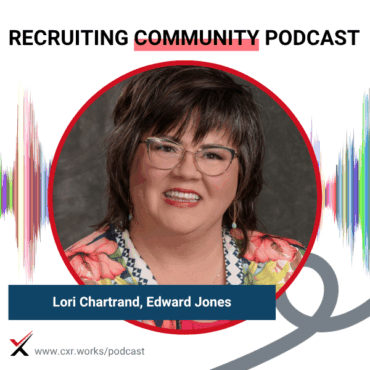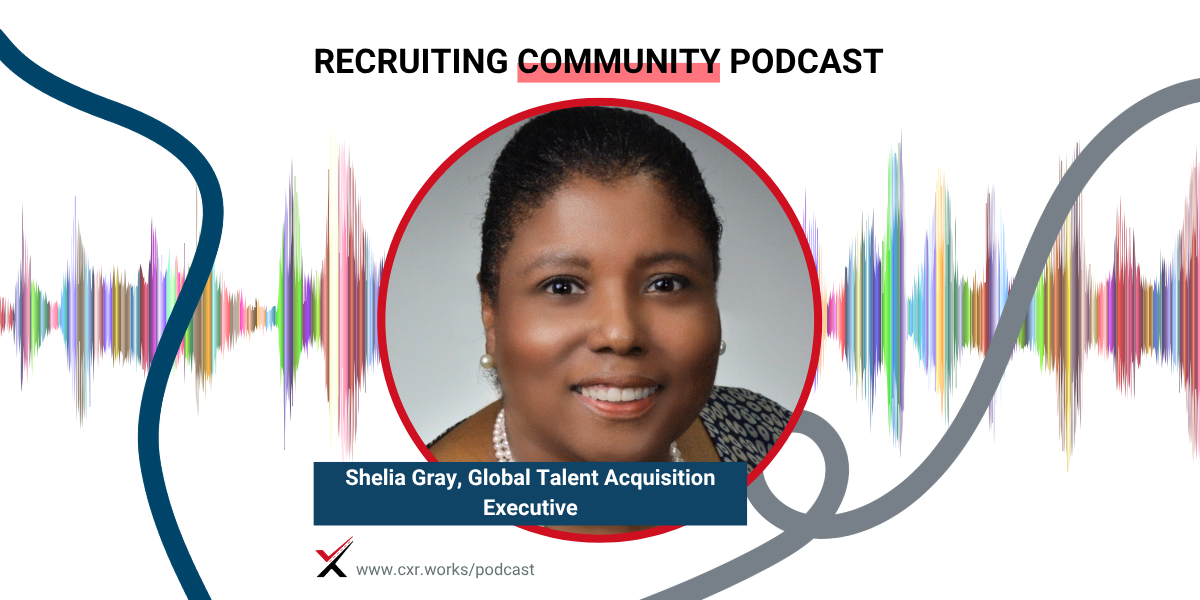
Managing Energy, AI, and the Joyful Mess of Modern Talent
Broadcasting from Unleash in Las Vegas, Chris Hoyt sits down with Lori Chartrand of Edward Jones for a candid conversation on stepping into a new leadership role, the impact of […]
 play_arrow
play_arrow
Beyond ‘Don’t Do X’: Compliance as Problem-Solving Cami Grace
 play_arrow
play_arrow
Career Crossroads: A New Series from the CXR Team Cami Grace
 play_arrow
play_arrow
Agentic AI in Talent Acquisition: What Recruiters Need to Know and Plan For Cami Grace
 play_arrow
play_arrow
Russ Mountain Memorial Scholarship Spotlight with Caroline Wittenauer Cami Grace

Title:
Navigating AI Hype and Culture Shifts in TA
Featured Guests:
Shelia Gray, Recruitment Architect
Hosts:
Chris Hoyt, Host, CareerXroads
Episode Overview:
Recorded live from the Unleash conference, Chris Hoyt talks with Shelia Gray about evolving talent acquisition practices, the rise of agentic AI, and the ongoing importance of employer branding. Shelia shares insights from her experience building global TA centers of excellence and reflects on what vendors and TA leaders are getting right—and wrong—about AI, candidate experience, and organizational transparency.
Key Topics:
AI trends and agentic AI applications in recruiting
Vendor evaluation and the importance of problem-solving alignment
Skills-based hiring versus competency-based strategies
Candidate expectations post-COVID
Employer branding and its growing influence
Cultural transparency and leadership accountability during layoffs
Strategic versus reactive approaches to TA and financial planning
Notable Quotes:
“Don’t get caught up in shiny objects. If a tool doesn’t solve a specific problem, it’s not worth it.” – Shelia Gray
“You have to sell more than just the job. You have to explain ‘Why us?’” – Shelia Gray
“There’s change, and then there’s chaos—constant, unpredictable change.” – Shelia Gray
“You can’t fake it. Candidates see through that.” – Shelia Gray
Takeaways:
Shelia Gray emphasizes the need for clarity, authenticity, and problem-focused solutions in talent acquisition. From managing AI expectations to reinforcing culture through employer branding, TA leaders must be agile and transparent. The true challenge is helping teams and leadership live through an era of ongoing disruption while remaining strategically aligned.
Want more conversations like this?
Subscribe to the CXR podcast and explore how top talent leaders are shaping the future of recruiting. Learn more about the CareerXroads community at cxr.works.
Announcer: Welcome to the Recruiting Community Podcast, the go-to channel for talent acquisition leaders and practitioners. This show is brought to you by CXR, a trusted community of thousands connecting the best minds in the industry to explore topics like attracting, engaging, and retaining top talent. Hosted by Chris Hoyt and Jerry Crispin.
We are thrilled to have you join the conversation.
Chris Hoyt: All right, everybody. Welcome back to the Recruiting Community Podcast. We usually do this weekly—meeting with TA leaders to talk about what’s top of mind for them. We try to keep it conversational. I’m scared of outlines, so this format works pretty well for us.
Today, we’re in a slightly different location—we’re at Unleash this year. Shaker has been kind enough to host us in a space where we can sit down and chat with some TA leaders we know, love, and respect. I’ve got Shelia Gray with me here. Shelia, why don’t you introduce yourself and tell everybody a bit about what you’re seeing out there? I’ve got questions, but let’s start with you.
Shelia Gray: Sure. Hi, I’m Shelia Gray, and I’m a recruitment architect. I’ve spent the last 10 to 15 years building talent acquisition COEs for global companies. I walk into organizations—whatever state they’re in—and figure out how they can best use talent acquisition to meet their business strategy. I love what I do.
Chris Hoyt: I have to say, you are one of my favorite TA leaders. You’re no-nonsense. If you walk the floor with Shelia and hear her talk with vendors, it’s very to the point—“That doesn’t make sense,” or “That does or doesn’t work.” So what’s your take? We don’t have to name names, but what’s your impression of the AI claims and delivery you’re seeing on the floor? Everything seems to be “AI this” and “agentic that.”
Shelia Gray: This year has been incredible when it comes to AI. This is my fourth year attending, and last year felt more focused on wellness programs—understandable post-COVID. But this year, every firm is trying to show how they’ve integrated AI, as if it’s the most critical thing.
I’ve seen AI in places I didn’t expect, including voice-to-AI integrations. The conversation has shifted to the next generation of AI—agentic AI. Last year, we were just talking about AI in general.
But here’s the thing: many people don’t know how to use it. I just came from a session on recruiting tools, and I always tell my team, “Don’t get caught up in shiny objects.” If a tool doesn’t solve a specific problem, it’s not worth it. When vendors reach out, I ask, “What problem are you solving for me?” If they can’t answer that, they’re a vendor—not a partner. A partner makes you better, and that’s worth spending money on.
Chris Hoyt: Exactly. Some of these tools are incredible, but they’re not right for every TA team. The magic is in having an honest conversation to figure out: Are you solving my problem? Or are you five years ahead of me?
Shelia Gray: If I were a vendor, I’d be very clear in my marketing—what problem do I solve, and who is my ideal customer? Some tools are better for small, standalone companies based on pricing and capabilities. If I’m global, I need to know if your solution can scale.
For example, my company does a lot of manufacturing. We’ve been looking into realistic job previews, which can be expensive. But I met a vendor here that can produce video-based previews that recruiters can send out to candidates. That’s a cost-effective option for smaller companies. Vendors should lead with that message.
Chris Hoyt: Yeah, too often it feels like a forest-for-the-trees situation. Okay, shifting a bit—do you think there’s a tactical shift that leaders are underestimating right now? Doesn’t have to be AI-related.
Shelia Gray: There’s been a shift toward skills—moving to a skills-based approach. But now Josh Bersin is challenging whether skills should be the priority, especially with AI potentially taking over certain tasks.
Most companies I’ve worked with struggle just to define competencies, much less validate or translate them into skills. So we’re way behind. If AI truly replaces some of these skill needs, we’ll have wasted time focusing on something that’s no longer relevant.
Chris Hoyt: That’s a good point. We are seeing some tools flip that concept on its head. I was surprised Josh said he’s no longer fully bought into it.
Let’s shift gears. From a talent attraction standpoint—have you changed your approach recently, or do you plan to?
Shelia Gray: There are always ebbs and flows in recruiting. Sometimes companies are in control, and other times, candidates are. Right after COVID, candidates had more control. They experienced remote work, better work-life balance, and started demanding more—wellness funds, flexibility, and so on.
Today, candidates are much more educated. They ask deeper questions—not just about the job, but about culture, growth opportunities, L&D. So now, you have to sell more than just the job. You have to explain “Why us?”
Chris Hoyt: Right. The differentiator now is the culture, not just the position.
Shelia Gray: Exactly. And I think candidates can be more demanding now because they have more access to information. Employer branding has become critical. I remember meeting my first employment branding person back in 2008—now, most of my peers have someone dedicated to it.
It’s about controlling the narrative. If you don’t, others will—Glassdoor reviews, layoffs, etc. Candidates want to know your story. They want to trust your brand.
Chris Hoyt: That’s such a great point. And honestly, some of these employer behaviors—like layoffs—have had lasting impacts. Candidates remember how companies treated people.
Shelia Gray: Absolutely. I worked at Sun Microsystems, and we took layoffs seriously. We cut costs, asked for employee suggestions, trained managers, arranged transportation for emotional support. The CEO even got thank-you letters for how well it was handled.
Now? You’ve got CEOs doing layoffs by email or cringeworthy video calls. That erodes trust. The safety and security people once felt at big companies is gone.
Chris Hoyt: I spoke to a recruiter recently who called some of those companies “gross” because of how poorly they handled layoffs. That perception sticks.
Shelia Gray: It really does. I’ve worked for companies with terrible Glassdoor reviews and poor reputations. You can’t sugarcoat it. Instead, you highlight why people stay—maybe it’s the community, the sense of purpose, or the growth potential.
But you can’t fake it. Candidates see through that. The real question is: will the people who join be the ones who can take you to the next level?
Chris Hoyt: And that might not be everyone. That culture isn’t for everyone—but it is for someone.
Shelia Gray: Exactly. But you’ve got to be honest. Not just attract someone—but the right someone who will stick around and lead.
Chris Hoyt: We ask everyone on the show this: if you were going to write a book about the state of things today, what would the title be?
Shelia Gray: My first thought? Live Through It.
Chris Hoyt: Live Through It. Love it. Tell me more.
Shelia Gray: I planned for this chaos. I knew the last four years would be an era TA had never seen before. There’s change, and then there’s chaos—constant, unpredictable change. That makes planning really hard, and TA thrives on planning.
You’ve got to live through it. Think about what’s on the other side. Prepare your team. Help leadership navigate an era they’ve never been in before. And unfortunately, many CFOs are reactive bean counters, not strategic financial planners. So when things get bumpy, they just cut costs.
You have to live through it—and help others do the same.
Chris Hoyt: So who gets the first signed copy of Live Through It?
Shelia Gray: I’d give it to Mark Strife. He was my manager years ago and one of the best I ever had. He fought for the TA function. He made me justify stakeholder analysis, use metrics, and engage clients on a deeper level. He made me see recruiting as strategic—not transactional.
Chris Hoyt: That’s awesome. Thank you so much for joining us, Shelia. I know there’s a lot going on at the conference, and we appreciate your time.
If you want to hear past episodes or see what’s coming up next, visit cxr.works/podcast. We’re always happy to connect with strong leaders who are willing to share what’s going on behind the scenes.
Shelia Gray: You’re welcome.
Chris Hoyt: Thanks, everybody!
Announcer: Thanks for listening to the Recruiting Community Podcast, where talent acquisition leaders connect, learn, and grow together. Visit cxr.works/podcast to explore past episodes, see what’s coming up next, and find out how you can join the conversation. We’ll catch you in the next episode.
Tagged as: employee engagement, Talent Acquisition, AI.
Chris Hoyt is the President of CareerXroads, a global peer community for talent acquisition leaders driving strategic change. With decades of experience leading recruiting innovation at Fortune 500 companies, Chris now advises enterprise TA teams on tech, process, and leadership. He’s a frequent speaker at conferences like SHRM, HR Tech, LinkedIn, and UNLEASH, and he’s known for pushing conversations beyond buzzwords to get to what really works in hiring. Through CXR, he connects top TA professionals to solve real problems, challenge norms, and shape the future of recruiting.

Broadcasting from Unleash in Las Vegas, Chris Hoyt sits down with Lori Chartrand of Edward Jones for a candid conversation on stepping into a new leadership role, the impact of […]